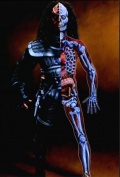Template:ArticleOfTheWeek/48
Note: This is a PC and NPC rated species. The Klingons (Klingonese: tlhIngan) are a humanoid warrior species that originates from the planet Qo'noS (pronounced Kronos), an M-class planet. One of the major powers of the galaxy, the Klingons are a proud, tradition-bound people who value honor and combat. The aggressive Klingon culture has made them an interstellar military power to be respected and feared. Klingons believe that they have the instinctive ability to look an opponent in the eye and see the intent to kill.
Klingons are known to be very strong and resilient physically. They resist diseases and injuries much better than their human counterparts. The ability is due to a characteristic called “brak’lul”. brak’lul refers to the system of redundancies within the Klingon physiology. The most common misconception of this is that Klingons have multiple organs that are redundant to each other, such as 2 hearts, 4 kidneys, 4 lungs, etc.
While the idea of multiple redundant organs is incorrect, it is not far from the truth. In actuality, the Klingon body does incorporate multiple redundancies for almost all of the vital functions. This is done by a lobe/chamber duplication, rather than full organs. For example, a human heart contains 4 chambers. In Klingons there are 8 chambers. Lungs would be 4 lobes, instead of 2 like humans, and so on. They have twenty three ribs (arranged in a sort of latticework). Some geneticists believe the redundancy within the organs, notably the lungs, evolved to give Klingons greater stamina on the battlefield.
The Klingon cranium is twice as thick as a human skull. This feature was specifically designed to protect the brain when receiving a blow to the head. Klingon foreheads contain ridges due to the skull having outgrowths on the frontal lobe. Interestingly, the forehead is not the only place where a Klingon possesses ridges. There are similar ridges running along the sternum, spine, and feet. In addition, the first metatarsal bone that leads to the big toe has an outgrowth on it. These growths on the Klingon skeletal structure have lead scientists to believe that at some point in the past, Klingons may have needed the additional protection on vital bone structures, and or may have had additional attributes that would help in a fight.
The full article can be found here
